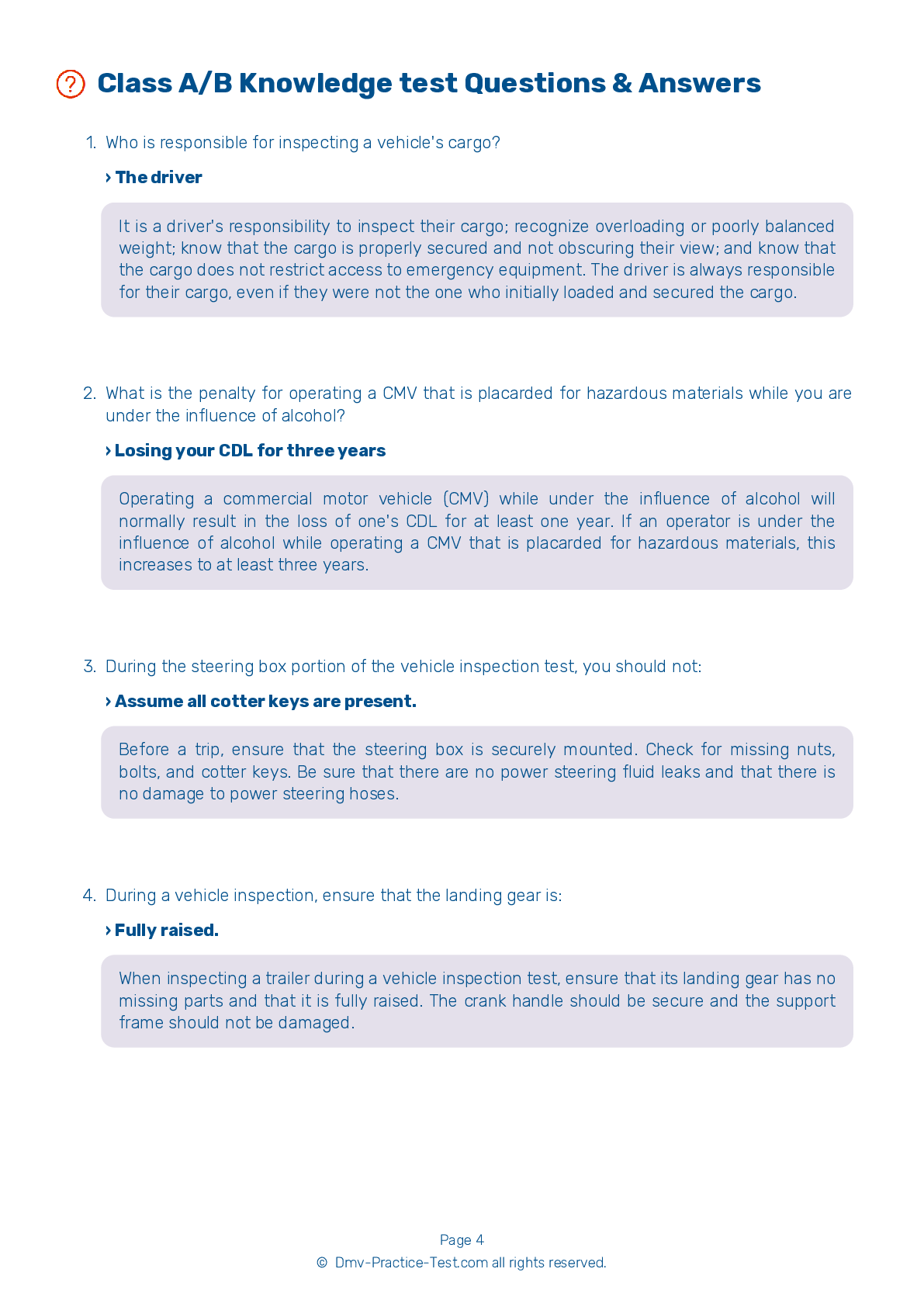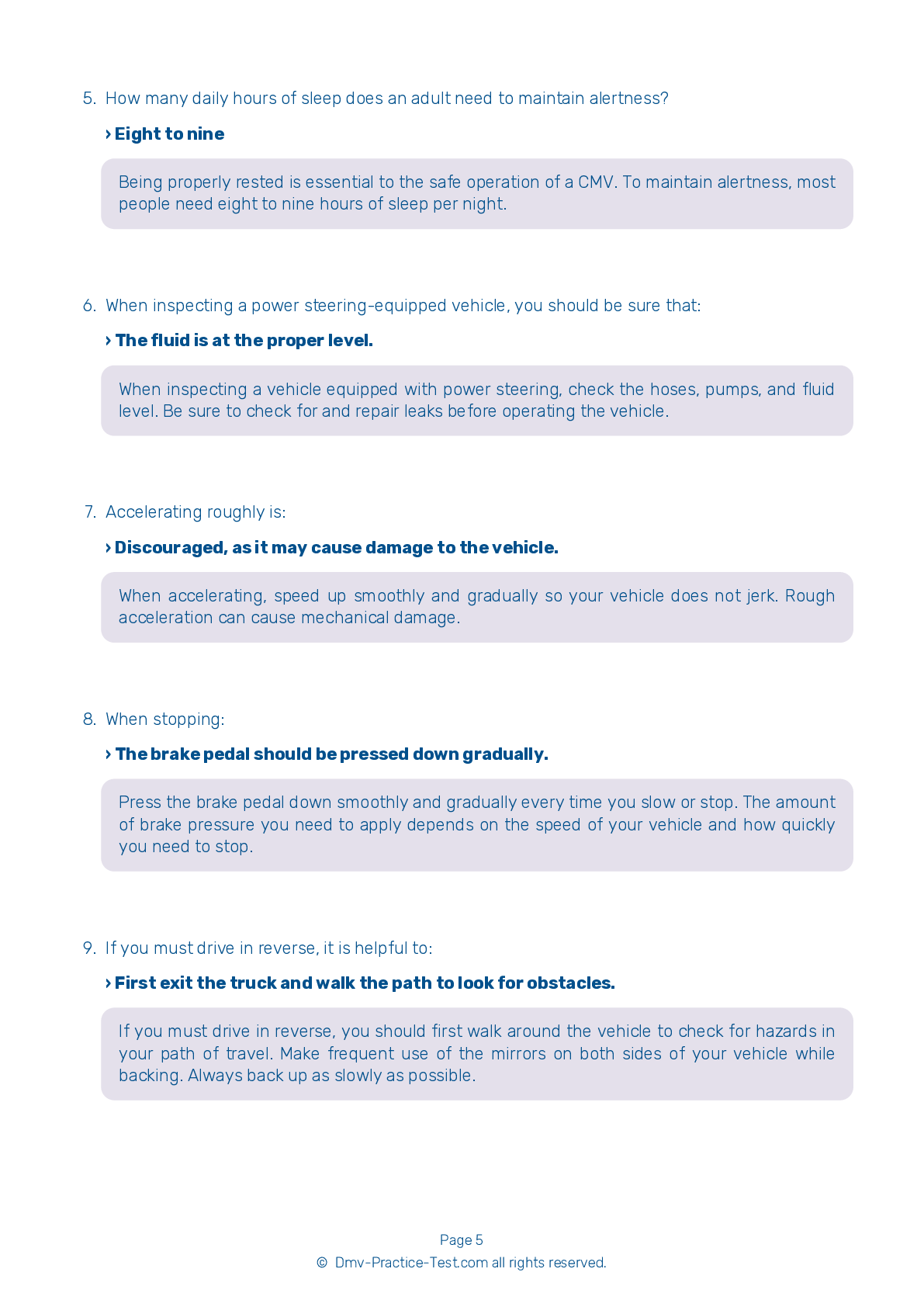Knowledge Test Class A #1
Class A Driving Test | Texas 2026 #1 Page 3 of 10
Train for FREE online with our Texas class A license test. The official exam test consists of several obligatory parts, with all of them checking your knowledge of different blocks of road rules. If you need to obtain a TX CDL class A permit in 2026, practice as much as possible. Free sample tests published on our website will help you check and improve your knowledge and boost your grades. Please bear in mind that CDL class A requirements may vary from state to state.
70
56
22
15 . The air pressure in a dual air brake system should build from 85 to 100 psi within:
45 seconds.
When inspecting a vehicle with a dual air brake system, you should wait for air pressure to build from 85 to 100 psi in both the primary and secondary systems. This should take about 45 seconds.
16 . When checking your tires, which of the following is not something that should cause concern?
Dual tires that do not come into contact with each other
When inspecting your tires, be alert to a number of potential problems, including air pressure that is too low or too high; bad wear; cuts; tread separation; dual tires that come into contact with each other or with parts of the vehicle; mismatched tire sizes; radial and bias-ply tires used together; and cut or cracked valve stems. Additionally, verify that there are no regrooved, recapped, or retreaded tires on the front wheels of the bus.
17 . If carrying a heavy load that is slowing you down, you should:
Keep the vehicle in second gear.
The right lanes of a roadway are generally intended for vehicles traveling more slowly than surrounding traffic. If being slowed down by a heavy load, you should stay in the right lane.
18 . When approaching a railroad crossing, you should:
Never try to outdrive an approaching train.
Reduce your speed as you approach a railroad crossing. Remember that you will not necessarily be able to hear a train, and don't assume that signals will warn you of its approach. Never try to outdrive an approaching train at a railroad crossing.
19 . For safety purposes, when should you turn off a retarder?
When driving in heavy traffic
Retarders are mechanisms in some vehicles that help slow a vehicle and reduce the need for braking. However, using a retarder may cause wheels to skid when they have poor traction. Turn off retarders when traveling under wet, snowy, or icy conditions.
20 . To make it as safe as possible to leave a stop, you should park:
By backing into a parking space.
Backing can be dangerous, so avoid doing it whenever you can. If possible, park in such a way that allows you to pull forward to exit your parking space.
21 . To use the stab braking method in an emergency situation, you should:
Apply the emergency brake.
The stab braking method for emergency stops involves fully applying the brakes until they lock up. The brakes are then released until the wheels start rolling, then the process is repeated.
2026 Texas | Frequently Asked Questions
To secure a CDL Doubles/Triples endorsement in Texas, you need to have a valid CDL license first. Then, study the Texas CDL handbook's section on Doubles/Triples endorsement. Afterwards, schedule an appointment at your local DMV to take the written test. Upon passing, you'll receive your endorsement. Remember, some employers may require additional on-the-job training.
To obtain a CDL Doubles/Triples license in Texas, you need to have a basic CDL license first. Then, pass the Doubles and Triples Endorsement Test which covers coupling and uncoupling, inspecting doubles and triples, and checking air brakes. Additionally, you must pass a vision test and provide proof of medical fitness.
While Texas doesn't require specific experience for a CDL Doubles/Triples endorsement, it's recommended to have practice handling such large vehicles. A CDL training course can provide this. You must pass a written test on handling double/triple trailers. Knowledge of coupling/uncoupling, inspecting trailers and air brakes is necessary. Professional training can greatly improve your chances of passing the test.
Yes, to obtain a CDL Doubles/Triples endorsement in Texas, you must pass an additional written test. This test covers information specific to driving double and triple trailers such as coupling and uncoupling, inspecting doubles and triples, and the proper procedures for pulling double/triple trailers. No additional road test is required for this endorsement.
The CDL Doubles/Triples endorsement test in Texas is a written exam, not a skills test. It focuses on knowledge such as how to couple and uncouple correctly, inspecting doubles and triples, and checking air brakes. You'll need to understand safe driving techniques for these larger vehicles, but you won't perform actual driving maneuvers during the test.
No, it's not permissible to operate double/triple trailers without a valid CDL Doubles/Triples endorsement in Texas. The endorsement is a legal requirement, demonstrating that the driver has the necessary knowledge and skills to handle such large vehicles safely. Driving without the appropriate endorsement could result in penalties, fines, or even loss of your CDL.
You can add the CDL Doubles/Triples endorsement to your current commercial driver's license. You don't need to initiate a new application for a CDL. However, you must pass the Doubles/Triples knowledge test. Once you pass, the Texas Department of Public Safety will add the endorsement to your existing CDL.
Yes, there are constraints for drivers with a CDL Doubles/Triples endorsement. For instance, these drivers must comply with specific weight and length regulations for their vehicles. They may also face restrictions related to hazardous materials transport. Additionally, they must adhere to hours-of-service rules set by the Federal Motor Carrier Safety Administration to ensure safe driving practices.
In Texas, the maximum legal weight for a semi-truck is 80,000 pounds without an overweight permit. The maximum length for a single trailer is 59 feet, while double trailers can be up to 28.5 feet each, and triple trailers up to 28 feet each. However, triple trailers are not legal on all roads in Texas.
Yes, there are specific safety guidelines for driving double/triple trailers. Drivers must ensure proper coupling and uncoupling of units, maintain safe following distance, and manage high-speed and curve control. They must also be aware of the "crack-the-whip" effect that can occur when changing lanes or turning. Furthermore, drivers must abide by Federal Motor Carrier Safety Administration regulations for hours-of-service.



